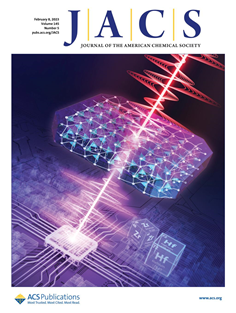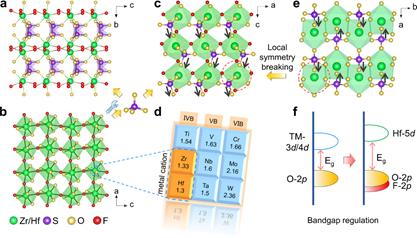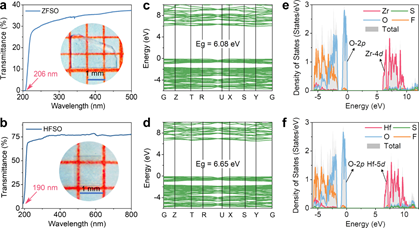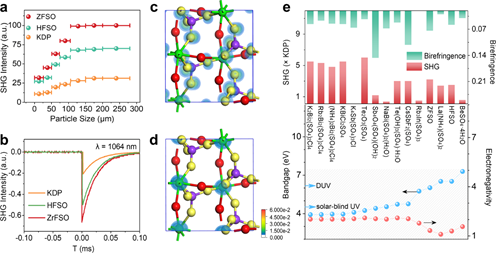Ultraviolet nonlinear optical materials can be applied to the second harmonic generation technology to extend the wavelength of solid-state lasers to the solar blind region (210-280 nm) and even the deep ultraviolet region (< 200 nm), which is of theoretical and practical significances in the optoelectronic field, esp. in short-wave communication, laser lithography, high-density storage and biological tissue imaging. However, the existing UV nonlinear optical materials are difficult to meet the practical requirements of advanced laser manufacturing technology because of their performances. Based on this imbalance, it presents a challenge to design, synthesize and create deep ultraviolet oxide crystals with large frequency doubling effect, wide ultraviolet transmission band and sufficient birefringence to achieve optical phase matching.

Research of ZHANG Chi's team was published in Journal of American Chemical Society
The research team of Professor ZHANG Chi from the School of Chemical Science and Engineering of Tongji University, who is a member of the European Academy of Sciences, has long engaged in research on transition metal sulfate. They proposed a "cationic compensation" approach and developed the first transition metal sulfate MF2 (SO4) (M = Zr (ZFSO), Hf (HFSO)) with UV transmission. They explored the physical nature of wide UV optical transmission and large frequency doubling effect synchronization gain by this transition metal sulfate. A paper entitled "Toward Large Second-Harmonic Generation and Deep-UV Transparency in Strongly Electropositive Transition Metal Sulfates" was recently published in the Journal of the American Chemical Society, 2023, 145 (5), 3040-3046). Three peer reviewers unanimously gave this paper high appraisal in the four dimensions of Significance, Novelty, Broad interest and Scholarly presentation. (1. …of the high quality expected for a publication in JACS…. 2. This is an excellent manuscript highly suited for JACS. 3. An excellent paper overall.) The paper and was selected by the JACS Editorial Board as the cover article of the latest issue of the journal. The article was published online on January 12th and has been downloaded and read more than 500 times by now.

"Cation compensation" approach
The research team put forward an approach of "cation compensation", and created the first sulfate frequency doubling crystals based on d0 transition metal with the help of d0 transition metal Zr and Hf, which showed strong frequency doubling effect and short ultraviolet cut-off edge. Zr and Hf are the transition metals with the lowest electronegativity. The d0 transition metals with strong electronegativity (i.e. weak electronegativity) and O/F with strong electronegativity can enhance the ionic properties of the target compounds, which is beneficial to obtain a wide optical band gap. Zr and Hf can form polyhedron [MOxFy] (M = Hf and Zr, x + y = 6 ~ 8). Due to the difference of electronic structure between fluorine/oxygen anions and metal center cations and fluorine/oxygen ligands, fluorinated d0 transition metal center polyhedron exhibits structure-oriented functions. These polar polyhedrons can induce the formation of uniform and parallel spatial accumulation of sulfate anions. Especially, polarizable fluorinated polyhedrons have large micro-second-order polarizability and strong optical anisotropy. When the polyhedrons are uniformly arranged, it is beneficial to produce large double frequency effect and birefringence

The research team used X-ray diffraction analysis of single crystal structure and first-principles theory for their simulation calculation
The research team also used X-ray diffraction analysis of single crystal structure and the first-principles theory for their simulation calculation. They discovered that ZFSO and HFSO can achieve solar blind ultraviolet/deep ultraviolet optical transmission, which can be attributed to polyhedral [MO4F4] (M = Zr, Hf) units formed by strong positive d0 transition metals. Experiments show that ZFSO and HFSO crystals have short UV absorb edge (ZFSO: 206 nm, HFSO < 190 nm), strong powder frequency doubling effect (3.2 × KDP (ZFSO) and 2.5 × KDP (HFSO)), moderate optical birefringence and good physicochemical stability. This research is of great significance in creating and developing new high-performance deep ultraviolet second-order nonlinear optical crystalline materials.

"Equal Network Molecular Design" approach
ZHANG Chi’s research team has made a series of research progress in cationic engineering assembly of frequency doubling crystals since 2021. They put forward an approach of "equal network molecular design" and created the first d0 transition metal oxyfluoride crystalline material MOF4H2 (M = Zr (ZOF), Hf (HOF)) with deep ultraviolet transmission. A paper entitled "KTiOPO4 configuration deep ultraviolet transmittance material with strong second harmonic generation by equal network design" was published in Journal of American Chemical Society (J. Am. Chem. Soc., 2022, 144 (44), 20394-20399, as a cover article). An effective strategy for constructing high-performance mid-infrared oxide crystals by partial fluorination is put forward. Their research paper "Partial fluorine-substituted oxide RbTeMo2O8F achieves huge frequency doubling response and large optical band gap in mid-infrared" was published in Journal of American Chemical Society (J. Am). Chem. Soc., 2021, 143 (32), 12455-12459, ESI TOP 1% highly cited papers). Their research solved the problem of optical frequency doubling effect and birefringence synchronous gain optimization of sulfate crystal and the research paper "Large frequency doubling effect and huge birefringence of high valence cerium fluorine sulfate crystal induced by highly polarizable polyhedron" was published in Journal of American Chemical Society (J. Am). Chem. Soc., 2021, 143 (11), 4138-4142, cover articles, ESI TOP 1% highly cited papers).
ZHANG Chi is the correspondent author of the paper, Associate Professor WU Chao, Associate Professor WEI Guangfeng and doctoral student JIANG Chunbo of School of Chemical Science and Engineering are the co-first authors of the paper, and Professor HUANG Zhipeng of School of Chemical Science and Engineering participated in the research work. The above-mentioned research work is supported by key projects of National Natural Science Foundation of China, Innovation Team of Ministry of Education, Innovation Team of key fields of Ministry of Science and Technology, discipline innovation plan of colleges and universities of Ministry of Education-State Administration of Foreign Experts Affairs and key projects of Science and Technology Innovation Plan of Shanghai Education Commission.
Article link: https://pubs.acs.org/doi/10.1021/jacs.2c08403? Ref=pdf